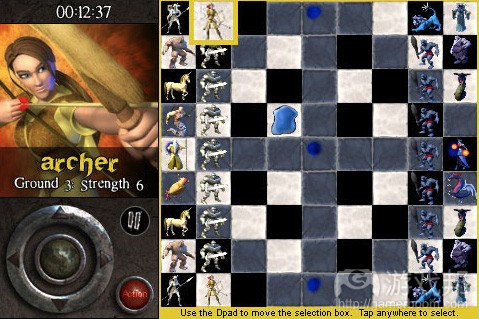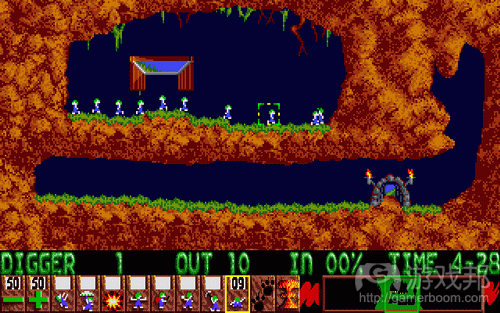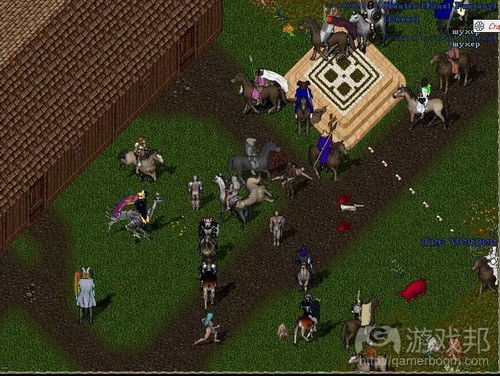开发者谈优秀游戏作品的若干设计原则
作者:Heidi E. Aycock
你存了几个月的钱,打算给自己的PC购买一款游戏游戏。你阅读评论,查看畅销榜单,咨询好友和亲戚,最终选定一个软件包。
在你投入资金时,你想知道自己的努力是否能够换来回报。游戏是否会向他人说的那样惊人?一款优质的游戏究竟是怎样炼成的?
若询问游戏设计师,他们会高谈论阔数小时。各种主题会在他们的答案中浮现——优秀的游戏通常富有趣味,它们平衡挑战和胜利元素,它们叙述精彩故事,融入杰出功能。优秀的游戏通常颇为简单;它们会扩展你的思维。
体验大量游戏,你将能够提高自己的游戏设计理念。这一哲学需包含如下原则。
趣味性第一
举例:Paul Reiche III的最新作品《星级控制》(游戏邦注:由Accolade发行);其他作品有《Archon》和《World Tour Golf》
在Paul Reiche III看来,优秀的游戏设计通常始于趣味性。Reiche表示,“在游戏方面,我没有像社会变革言论那般博学的观念。在我看来,优质游戏的试金石就是其包含多少趣味性。”
他的答案听起来有些平淡无奇,但Reiche随即详细谈及这一基本原则。他解释表示,设计师经常重复描述自己的游戏,但从未谈及“最有趣的部分是……”
他表示,“因此,游戏的任何趣味元素纯属偶然。优秀的游戏作品需要具有趣味核心,这通常是个一句话的描述,陈述游戏为何富有趣味。”
凭借自己的趣味意识,Reiche花时间研究我们现实世界的游戏。他抽取游戏的趣味核心。例如,在捉迷藏游戏中,扮演隐藏者最有趣的地方在于,寻找适当的隐藏地点。然后他开始思考如何将此转化成电脑游戏。
除瞄准现实世界,寻找趣味标准外,Reiche还查看过去的成功作品。他的新作《星际控制》就是受传统8位元雅达利游戏《星际奇兵》启发。查看《星际奇兵》画面,你会自鸣得意地翻白眼。但游戏在当时算是颇具趣味,而且今天看来依然非常不错。Reiche表示,“这些游戏经常遭到忽视,他们是基本设计原则的来源。”
他还和好友共同体验游戏。他表示“我们每周会安排一个晚上玩游戏,我们通常会选择看起来颇为有趣的游戏。我们通常不玩电脑游戏,而是选择棋盘游戏。”
Reiche的理念(游戏邦注:即游戏设计原则就是设计有趣的游戏)似乎有些过于基础。但就如Reiche的同辈伙伴Brent Iverson和Dan Bunten所述,趣味性是杰出游戏作品的根本要素。但要找出这一元素,我们需要花费许多时间筛选不必要的游戏细节内容。
根据自己的设计经验,Bunten表示,“我们经历这些设计—体验—设计—体验循环过程,进而找到趣味路线,然后基于我们眼中的必要元素创建内容。”Iverson对于这一理念的看法是:“有时,你会在纸上设计出看似不错的设计,但其中只有一小部分内容颇具趣味,此时你需要锁定这一小部分元素,将其他内容弃置。”
也许趣味性是个太难以捉摸的词汇——成功游戏设计师也很难给趣味性下定义,虽然他们继续制作出颇具魅力的游戏作品。作为热门游戏作品的设计行家,Paul Reiche非常注重“趣味”元素,基于此制作出众多颇受欢迎的游戏作品,有的有具体的趣味定义,有的没有。
我们渴望简单性
举例:Dave Jones最新作品《疯狂小旅鼠》,由Psygnosis发行;其他作品包括《合金装备》和《血腥钱》
当Dave Jones及其团队制作《疯狂小旅鼠》时,他们决定突出简单性。在他们看来,设计精良的游戏作品通常很简单。
Jones表示,“《俄罗斯方块》就是简单性的最佳代表,但其非常富有沉浸性。《疯狂小旅鼠》的复杂程度很低,而这就是游戏的趣味性所在。但要做到保持简单性非常困难。我们花费整整6个月时间设计这款游戏。这是段非常漫长的时间。”
《疯狂小旅鼠》丝毫不注重描述元素。一群小旅鼠势不可挡地向前行进。你必须赋予这些生物特殊技能,协助他们克服障碍。当然,技能通常会受到限制,解决方案也不总是那么显而易见。
出于优秀游戏设计目标,Jones将技能由20种缩减至8种。“游戏的控制方式越简单,内容就更具可玩性。”
“我们觉得通过这8种技能,我们可以向玩家呈现所有内容。当我们开始着手技能时,我们发现玩家凭借其中3种技能就可以完成这些操作。小旅鼠是否能够通过其他2-3种功能完成特定技能的操作?”
我们最终获得的是一款在许多设计师看来极其简单但又非常有趣的游戏。Origin Systems Richard Garriott也对这款Psygnosis热作表示赞许,“我没有想到《疯狂小旅鼠》会成为一款如此受欢迎的游戏,但游戏设计巧妙、简单通俗。”就连筋疲力竭的Jones也表示,这是自己完成项目后唯一想玩的游戏。
也许简单性是多数设计师应该关注的游戏设计元素。Reiche非常推崇简单的游戏作品:“颇受追捧的原生游戏通常都非常简单。”
但在Jones看来,好的游戏设计会通过内在简单性大放异彩。他表示,“最终成品会和《疯狂小旅鼠》一样具有可玩性,但同时呈现《银河飞将》的画面效果。这是设计师应该争取的目标,要做到这点绝非易事。”
情节是重点
举例:Roberta Williams的最新作品《国王密使V》,由Sierra On-Line发行;其他作品包括《上校的遗产》和《Mixed-Up Mother Goose》,Roberta Williams的游戏通常设有分散的胜利结尾。在她看来,好的游戏会以有趣的方式带你走向胜利。
她表示,“我们开始越来越着眼于情节元素。主人公是否是讨人喜欢的角色?谁是反面角色?”
自她开始制作历时长久的《国王密使》系列以来,探险游戏发生很大变化。Williams表示,“过去我刚开始设计探险游戏时,游戏并没有融入多少情节元素。玩家的主要任务是同巨魔战斗,收集财富。”
随着用户口味的日益复杂化,游戏设计师开始丰富自己的写作技巧。据Williams表示,“游戏开始逐步转变成互动小说,我们开始越来越注重情节、角色和适当写作技巧。”
Williams将自己的探险游戏视作电影和书籍。她希望自己的作品能够像电影那样精心雕琢,富有沉浸性。玩家必须同角色达成共鸣。谜题必须配合情节,而不是一味突出自己。
通过一定程度的互动元素平衡游戏情节是杰出探险游戏设计过程中最艰巨的任务。Williams表示,“在探险游戏中,主角通常由玩家控制,创作者对于主角的具体操作内容没有控制权。主角有点像匹需要你将其抓住然后进行控制的野马。”
她唯一能够控制主角的时刻是编程控制顺序阶段。这里,玩家被迫通过顶部的对话和剖面图寻找线索。这些序列促使游戏向前迈进。
“在此你可以控制玩家,要求他们听从你的节奏。但随后他们就开始独立操作。”
凭借优秀的情节内容和写作技巧,Williams设计出能够兼任现实生活逃离出口的游戏作品。在她看来,充当生活逃离出口及带来获胜快感是《国王密使》的趣味性所在。
技术第一
举例:Richard Garriott最新作品《创世纪VII》和《黑暗之门》,由Origin Systems发行;其他作品包括《创世纪》系列和《Martian Dreams》
和《国王密使》一样,Richard Garriott的《创世纪》游戏已推出很长时间。但和《国王密使》不同,《创世纪》的成功要诀在于复杂的技术元素(游戏邦注:情节元素其次)。
Garriott 表示,“当我坐下来设计游戏时,我通常会在初始就设定若干根本目标。在编写代码前,我通常会从概念上确定自己所要呈现的游戏信息和主要技术成就。”
在Garriott看来,技术元素推动游戏设计进程。他表示,自己可以编写出精彩故事,让电脑对其进行叙述,但若没有密切关注设备局限,他就不知道自己需要编写多少代码。他甚至不知道构思是否具有可行性。
“另一方面,若你初次运用这一技术,你可以这么说:‘我要设计出配合这一技术的故事。’此故事在这一技术范围内顺利运作。”
由于Garriott重新设计各款《创世纪》游戏的技术元素,他给故事情节带来了新的可能性空间。例如,在各款《创世纪》游戏中,Garriott能够更详细地呈现Britannia世界。到了《创世纪V》,他可以在房间中陈列家具,这他就能够引入可供玩家弹奏的古钢琴——只是因为这具有可行性。由于他无法单出于美学原因表明古钢琴出现的合理性,因此他对乐趣进行改造,这样当玩家点击特定按键时,秘密通道就会出现,然后呈现游戏的一大主要内容。
通过创造更多细节和更多可能性,Garriott设计出众多能够让玩家进入不同虚拟世界的游戏系列。他表示,《创世纪》系列的有趣之处在于,沉浸性是个独立事实,一个因每次安装变得越来越丰富的真实画面。
Garriott表示,“《创世纪》颇具趣味,因为从打开盒子那刻起看到的所有内容都促使你觉得,自己也许真的即将进入一个真正的世界。整个游戏的虚幻故事令玩家能够跳脱到Britannia世界中。”
依然呈现更多乐趣
举例:Dan Bunten最新作品《指挥总部》,由MicroProse发行;其他作品包括《M.U.L.E.》和《Robot Rascals》
捆绑所有优秀游戏作品所包含的元素,然后用力甩动。被筛下的通常是源自尽情享受的独特发展元素。
Dan Bunten表示,“寻求乐趣不是愚蠢举动。乐趣是你情感状态的测量计。乐趣是你获得的总体感觉,但带来乐趣的是意想不到的发展机会。”
在Bunten看来,乐趣扮演着重要角色,是我们生活不可或缺的组成要素。他表示,“这是智能物种的特性,他们参与看似没有回馈的活动。作为一种文化,我们将这些活动归类成游戏。这些是没有任何外在报酬的活动。奖励都采用内在形式。”
他解释我们需要获得乐趣的原因。他表示,“随着智力水平的提高,我们的刺激需求也跟着增长。大脑存在理想的激励程度。”若你的大脑在1天内没有达到这一水平,你就需要进行游戏。
通过消耗日刺激配额,你让自己的心理和精神状态都得到发展。你同时还可以提高自己的智能水平。“具有一定深度的内容会促进你成长,让你进行更深入的思考,进行更多的学习,促使你同游戏环境之外的事物建立联系。”
据Bunten表示,当你完全沉浸于一款打破自己智力极限的游戏时,你会觉得自己进行的活动更富有意义。他表示,“由于游戏空间的丰富性,而且同外部世界的真实经历建立联系,你将获得一个更深刻的体验。”
在Bunten看来,优质的游戏能够给玩家带来益处。乐趣是大脑的维生素,是智力的必要养分。或者也许如Reiche所述:“优秀电脑游戏的本质和现实游戏初衷相同:是消遣时间的活动。”
但无论如何,些许的趣味性永远不会给玩家带来伤害。(本文为游戏邦/gamerboom.com编译,拒绝任何不保留版权的转载,如需转载请联系:游戏邦)
Principles of good game design. (World of Electronic Games)
by Heidi E. Aycock
You saved up for months to buy a new game for your PC. You read the reviews, investigated the bestseller lists, asked your friends and relatives, and settled on a package.
As you lay your money down, you wonder if your diligence will be rewarded. Will the game be as incredible as everyone says? What makes a good game, anyway?
Ask game designers and they can talk for hours. Various themes surface in their answers–good games are fun, they balance challenge with success, they tell good stories, they have whiz-bang features. Good games are simple; they help you expand your mind.
Play enough games and you’ll probably develop your own philosophy of game design. Certainly it will include a few of these principles.
Fun Comes First
Name: Paul Reiche III Recent Release: Star Control from Accolade Other Games: Archon and World Tour Golf
For Paul Reiche III, good game design starts with good fun. “I don’t have any highbrow ideas of games as statements of social change,” says Reiche. “To me the litmus test of a good game is how much fun it is.”
His answer may sound obvious, but Reiche goes into great depth about this basic principle. He explains that designers can describe their newest games and nauseam but never say, “The fun part is. . . .”
“Consequently,” he says, “any fun in the game is completely accidental. A good game has to have a fun core, which is a one-sentence description of why it’s fun.”
Exercising his sense of fun, Reiche spends time thinking about games we play in the real world. He picks out the fun core of the game. In hide-and-seek, for example, the fun part of being the hider is finding a good place to hide. Then he thinks about how that can translate to a computer game.
Besides looking to the real world for standards of fun, Reiche examines successful games of the past. His latest release, Star Control, was inspired by an old 8-bit Atari game called Star Raiders. Look at the graphics of Star Raiders and you’ll smugly roll your eyes. But the game was great fun back then, and it’s still fun today. “I think those games are overlooked as a source for fundamental game design,” says Reiche.
He also plays games with friends. “We have a game night once a week when we play games we want to play or games that look interesting,” he says. “We usually don’t play computer games. We usually play board games.”
Reiche’s philosophy–that a good game design is simply a fun game–may seem too basic. But, as Reiche’s contemporaries Brent Iverson and Dan Bunten agree, fun is the essential element of an excellent game. Isolating that element, though, can require many hours of sifting through unnecessary game details.
Of his own design process, Bunten remarks, “We go through these designing-playing-designing-playing-type iterations to follow the thread of what’s fun and build on the foundation of what we think is needed.” Iverson echoes this philosophy with his admission, “There are cases where you design something that looks good on paper and there’s only one small part of it that’s fun. You have to focus on that and throw the rest away.”
Perhaps fun is too intangible a term to pin down–successful game designers can’t readily define what fun is even though they continue to produce engaging games. As an old hand at designing popular games, Paul Reiche takes his “fun” seriously enough to build some of the most entertaining diversions around, with or without a working definition.
We Crave Simplicity
Name: Dave Jones Recent Release: Lemmings from Psygnosis Other Games: Menace and Blood Money
When Dave Jones and his cohorts built Lemmings, they decided to emphasize simplicity. They thought the best-designed games were also the least complicated.
“Tetris is the ultimate example of the most ultimately simple game, but it’s so addictive,” said Jones. “Lemmings is complexly simple. That’s what’s fun about it.” He found, however, that attaining simplicity posed great difficulty. “We took a good six months to design this game,” muses Jones. “That’s an unusually long time.”
Lemmings almost defies description. A group of rodents move irresistibly forward. You endow these creatures with special skills that help them overcome obstacles. Of course, the skills are limited and the solutions are not always obvious.
In the interest of good game design, Jones whittled down the skills from a collection of 20 to a group of 8. “The simpler you can make the control of the game, the more playable it is.
“We thought that with these eight skills we could throw anything at the players. When we started to take skills out, we figured they could do these things with these three skills. Can this lemming replicate what this skill can do with two or three other functions?”
The final product is a game that many designers call ingeniously simple but obsessively interesting. Origin Systems’ Richard Garriott adds his opinion to the body of praise for this Psygnosis hit. “I would not have been able to predict Lemmings would be such a popular game, but it’s slick and simple.” Even the jaded Jones admits that this is the only game he has ever wanted to play after finishing the project.
Perhaps simplicity is an aspect of game design that more designers should note. Reiche extols the virtue of an uncomplicated game: “The really blisteringly original games are incredibly simple.”
To Jones, however, the best game design would sprinkle glamour over innate simplicity. “The ultimate game would be one that’s as playable as Lemmings but has the [cinematic-style] graphics of Wing Commander,” he says. “That is something that people have to work towards and that is very difficult to do.”
The Plot’s the Thing
Name: Roberta Williams Recent Release: King’s Quest V from Sierra On-Line Other Games: The Colonel’s Bequest and Mixed-Up Mother Goose Roberta Williams designs games that have a discrete, victorious end. A good game, in her view, takes you to that final victory in an interesting way.
“More and more, we’re thinking in terms of the plot,” she says. “And is the protagonist a likable person? And who is the antagonist?”
Adventure games have changed a lot since she began her long-lived King’s Quest series. “In the old days, when I first started designing adventure games, there wasn’t much plot,” Williams says. “You kind of ran around beating up trolls and gathering treasure.”
As consumers have developed more sophisticated palates, game designers have spiced up their writing skills. According to Williams, “More and more, [games are] turning into interactive fiction, and more and more, we’re concentrating on plot, the characters, and proper writing technique.”
Williams equates her adventure games with movies and books. Her creations aspire to be as well crafted and as absorbing as those you would find in a motion picture. Players must be able to identify with the characters. Puzzles must fit into the plot without drawing attention to themselves.
Balancing a game’s plot with an acceptable amount of interactivity is one of the toughest tasks in designing a good adventure game. “In the case of an adventure game, the protagonist is controlled by the player,” Williams explains. “The writer has no control over what the protagonist does. The protagonist is kind of like a wild horse that you have to catch and rein in.”
The only time she can direct the protagonist is during program control sequences. These are the parts of the game where the player is forced to find clues through overhead conversations and cutaway scenes. These sequences keep the game moving.
“It’s at those points that you can rein the players in and make them dance to your tune,” she says. “But then they’re off and running.”
With both good plots and good writing techniques, Williams designs games that double as escape hatches from everyday life. That escape, combined with the sheer pleasure of winning, is what she finds fun in the King’s Quest games.
Technology First
Name: Richard Garriott Recent Release: Ultima VII, The Black Gate from Origin Systems Other Games: Ultima series, Martian DreamsMartian Dreams
Like King’s Quest, Richard Garriott’s Ultima games have been around for a long time. Unlike King’s Quest, however, Ultima’s key to success is its technological sophistication–plot comes later.
“When I sit down to design a game, I usually have a few basic goals that I am very much aware of from the onset,” Garriott says. “The message of the game and the major technological achievements I want to take on–I usually have these well in hand conceptually before I put a line of code in.”
For Garriott, technological issues drive the game design process. He says he can write a good story and try to make the computer tell that story, but without close attention to the limits of the machine, he won’t know how much code he’ll have to write. He won’t even know if the idea is possible.
“On the other hand, if you first develop the technology, then you can say, ‘Okay, I can design a story that does that.’ That story is well within the scope of the technology.”
As he redesigns the technology for each new Ultima, Garriott carves the plot out of the new possibilities. For example, in each of the Ultima games, Garriott has been able to show the world of Britannia in more detail. By Ultima V, he could put furniture in the rooms, so he included a harpsichord the player could play–just because it was possible. Since he couldn’t justify the harpsichord on aesthetic grounds alone, he rigged the instrument so that when players press a certain key, a secret passage opens and reveals one of the major parts of the game.
By creating more detail and more possibilities, Garriott has built a series that wraps players in the fantasy of another world. He says the fun part of the Ultima series is that immersion in a separate reality, a reality that grows richer and richer with each installment.
“Ultimas are fun,” Garriott says, “because everything from the moment you open the box is there to compel you to believe that you might really be going to a real place. The fiction of the whole game is there to support the reality of your escape to the world of Britannia.”
And Still More Fun
Name: Dan Bunten Recent Release: Command HQ from MicroProse Other Games: M.U.L.E. and Robot Rascals
Bundle up all the elements of a good game and give them a vigorous shake. What sifts through is a special kind of growth that comes from having a good time.
“Fun is not a fatuous activity,” says Dan Bunten. “Fun is the meter on your emotional state. Fun is the summary feeling that you’ve got, but what’s contributing to that are unexpected opportunities for growth.
According to Bunten, fun takes on an important role as an indispensable part of our lives. “It’s a characteristic of intelligent species to engage in activities for which there seems to be no reward,” he says. “As a culture, we class those activities as play. Those are things that don’t have any extrinsic reward. The reward is all intrinsic.”
He explains why we need fun. “As intelligence rises, the need for stimulation also rises,” he says. “For every brain, there is an optimum level of arousal that your brain wants to get to.” If your brain doesn’t reach that level during the day, you’ve got to play.
By consuming your daily quota of stimulation, you promote your psychological and spiritual growth. You can also expand your intellectual capacity. “Some things have a certain amount of depth that pushes you, makes you think a little deeper than you have, makes you study a little more, makes you connect with things outside of the game environment.”
According to Bunten, when you become completely absorbed by a game that pushes you to your intellectual edges, you feel like what you’ve done is more deeply significant than what you would have done otherwise. He asserts, “Because of the richness of the environment, the connection to outside, real-world experiences, you come away with a more profound experience than you would have had without those elements–even if the entertainment value is equivalent.”
Good games are good for you, by Bunten’s account. Fun is a vitamin for the mind, essential nourishment for your intellect. Or perhaps Reiche comes closer to the truth when he says, “A good computer game is pretty much the same thing that games were always meant to be: something to wile away some time with.”
But whatever you rationale, whatever your excuse, don’t worry. A little fun never hurt anybody.(Source:atarimagazines)
下一篇:演示如何设置玩家触屏移动控制方式












































 闽公网安备35020302001549号
闽公网安备35020302001549号